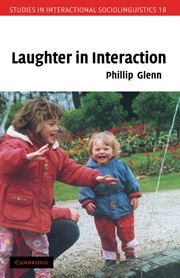Book contents
- Frontmatter
- Contents
- List of figures and tables
- Acknowledgments
- Transcription symbols
- Introduction
- 1 Towards a social interactional approach to laughter
- 2 Conversation analysis and the study of laughter
- 3 Laughing together
- 4 Who laughs first
- 5 Laughing at and laughing with: negotiating participant alignments
- 6 Laughing along, resisting: constituting relationship and identity
- 7 Closing remarks
- Notes
- References
- Index
4 - Who laughs first
Published online by Cambridge University Press: 08 August 2009
- Frontmatter
- Contents
- List of figures and tables
- Acknowledgments
- Transcription symbols
- Introduction
- 1 Towards a social interactional approach to laughter
- 2 Conversation analysis and the study of laughter
- 3 Laughing together
- 4 Who laughs first
- 5 Laughing at and laughing with: negotiating participant alignments
- 6 Laughing along, resisting: constituting relationship and identity
- 7 Closing remarks
- Notes
- References
- Index
Summary
Because shared laughs begin recurrently through a sequence in which one person's laughter invites others to join, the issue of “who laughs first” becomes an important one. From a conversation analytic perspective this question gets framed sequentially. Identity is treated in terms of “who” holds the floor and is current speaker; who is some co-present other; who offers an invitation to laugh; who is the recipient; who is teasing; who is the victim of a tease; who is telling about troubles; etc. These sorts of “who”s shape (and get constituted through) the organization of talk in specifiable ways. Participants orient to them, and they are demonstrably relevant to the analysis of shared laughter initiation.
“Current speaker” designates the party (usually an individual, but possibly a group, as in the case of audience laughter) who occupies a turn at talk and has some degree of rights and/or obligations to produce speech and/or action. “Other” designates participant(s) not holding the turn at talk. These terms reflect the premise, put forth by Sacks, Schegloff, and Jefferson (1974), that turns are a scarce resource, available only to one party at a time. Although this is not essential, people in all sorts of interactions organize their participation in this way. The sequential roles “current speaker” and “other” come up for grabs at each transition relevance place (TRP) (Sacks, Schegloff, and Jefferson, 1974).
- Type
- Chapter
- Information
- Laughter in Interaction , pp. 85 - 111Publisher: Cambridge University PressPrint publication year: 2003



